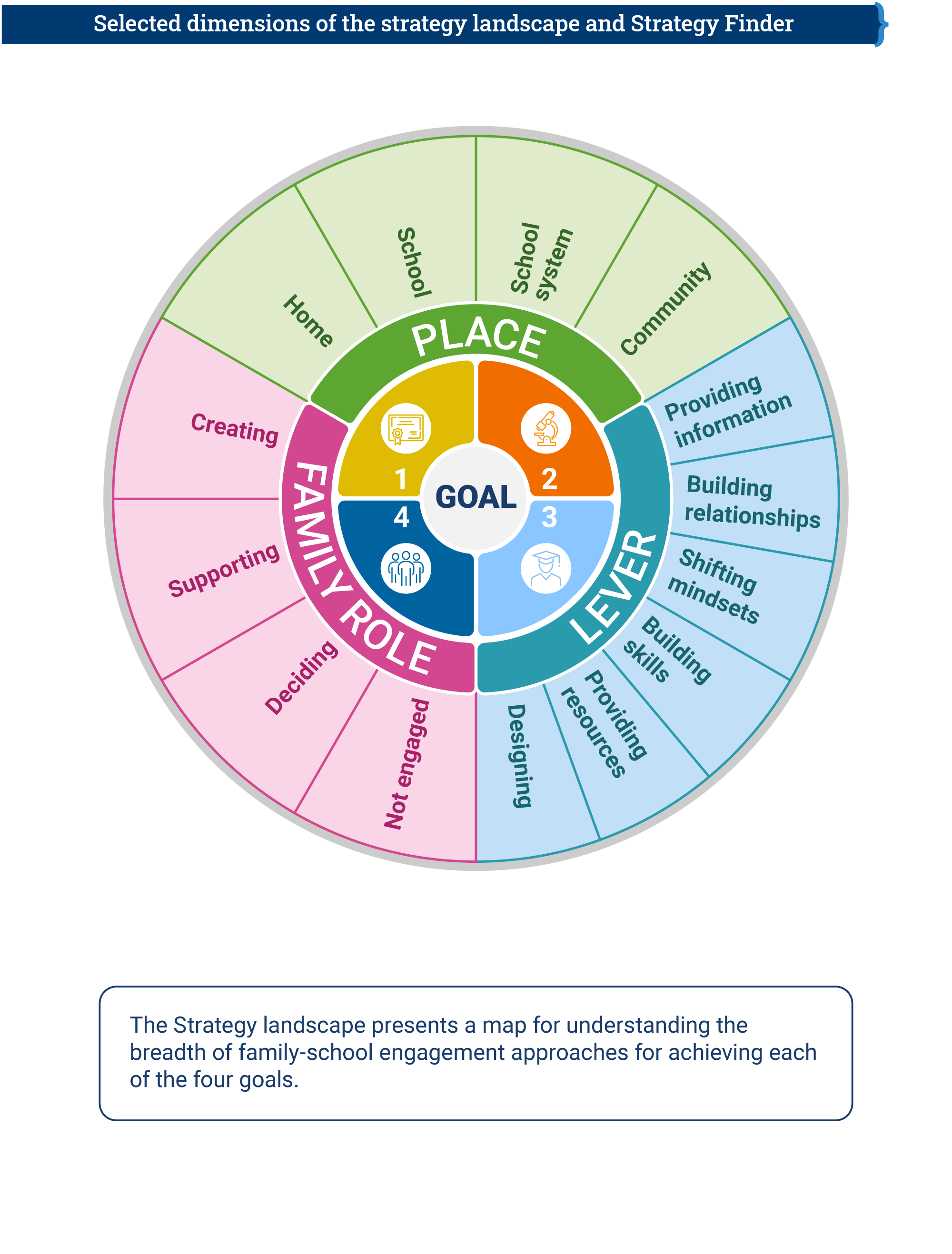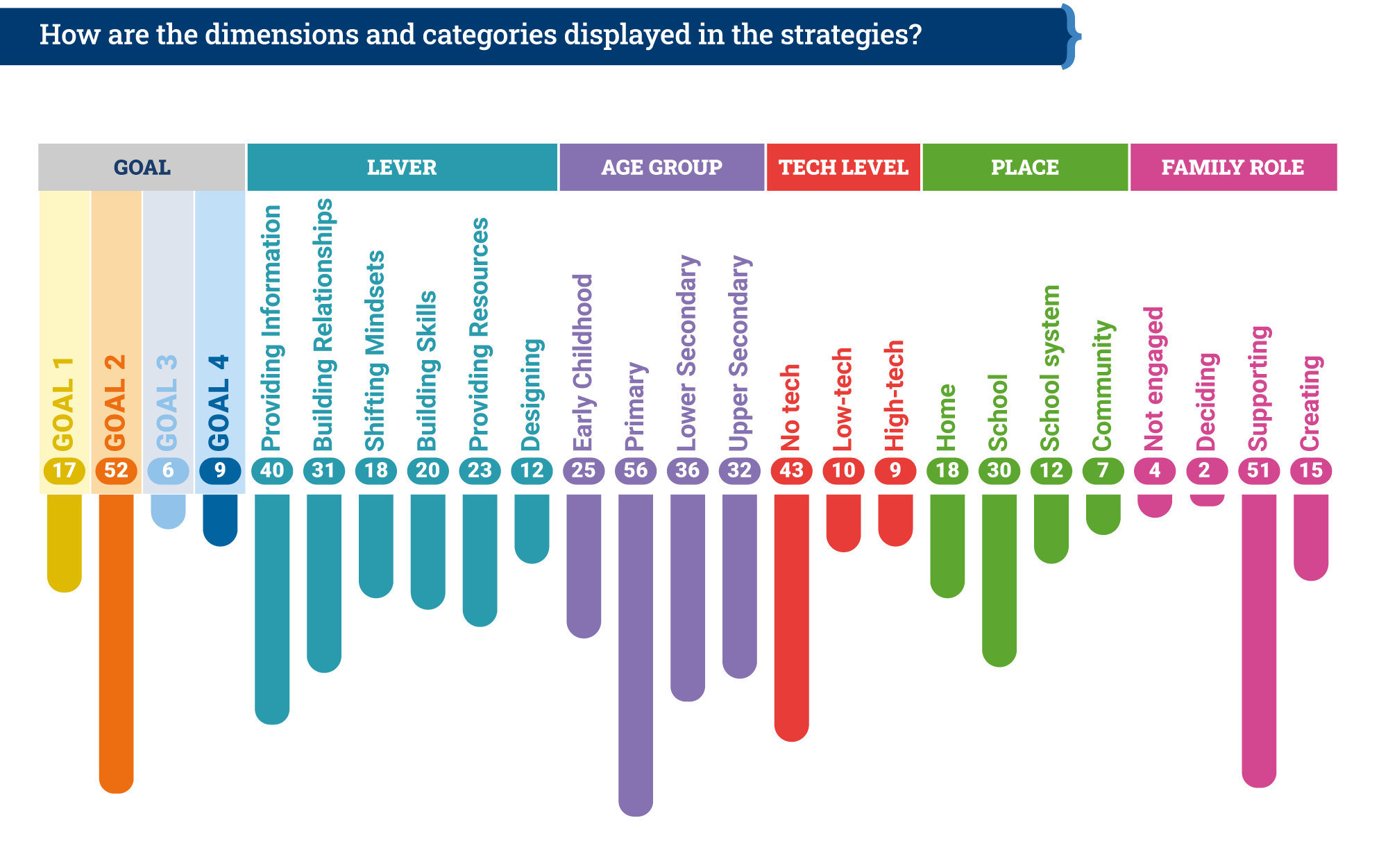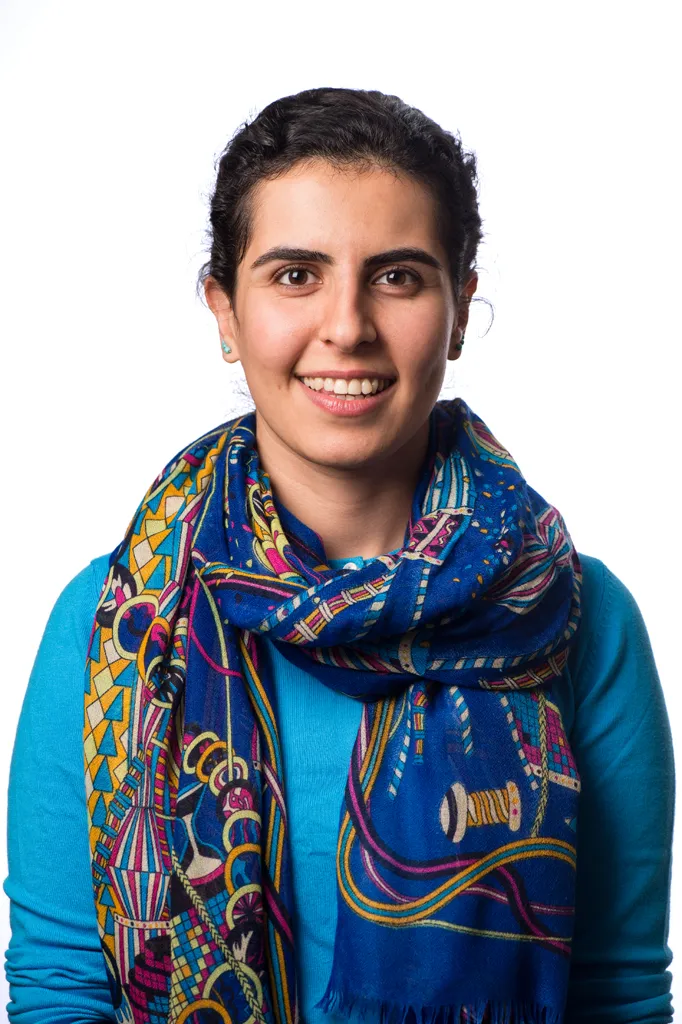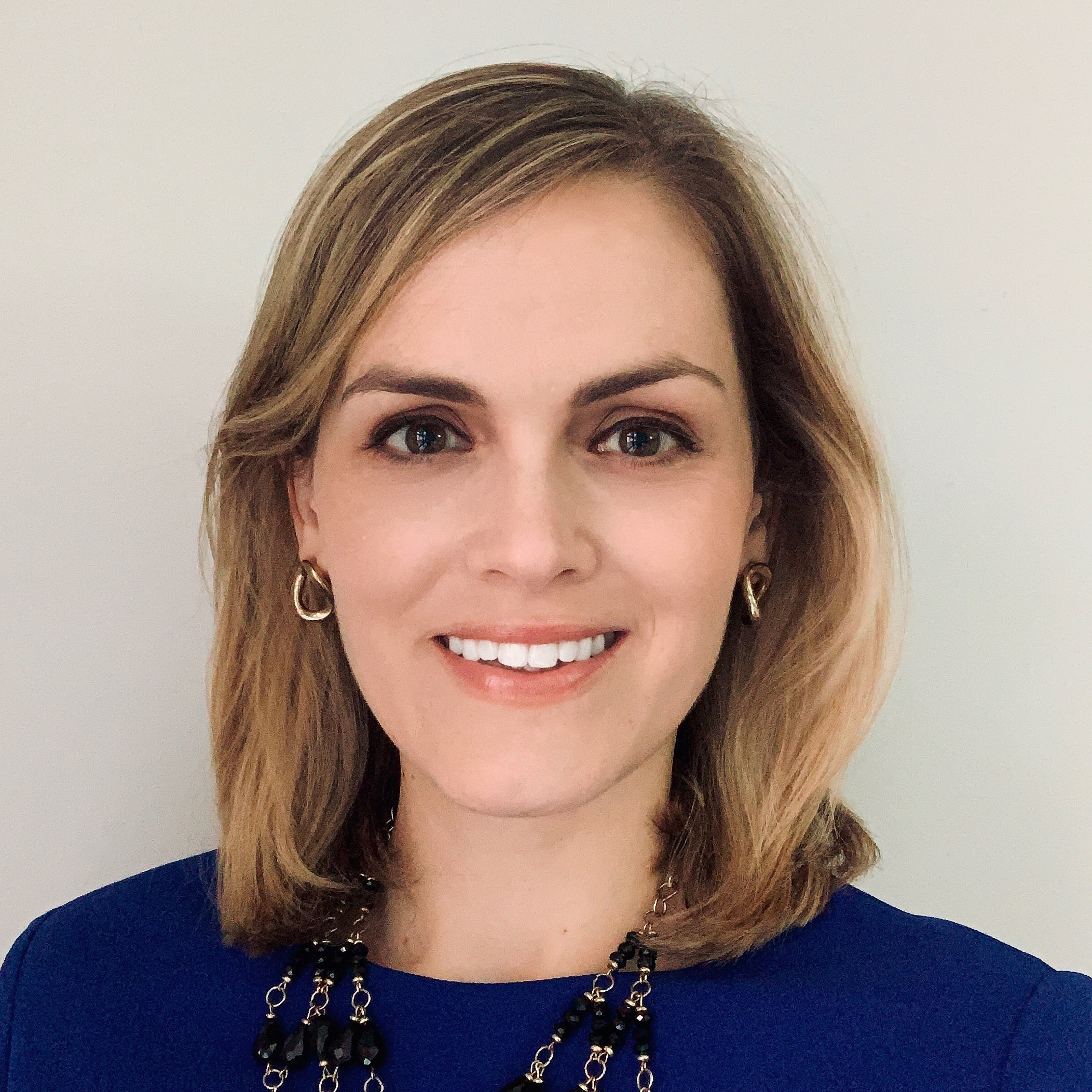Strategy landscape
Families and schools can—and do—work together in many ways. Strategies vary first and foremost by goal: what do families and schools want to achieve together? Some try to help at-risk students stay in school, while others try to help struggling students improve their academic outcomes. Still others try to fundamentally change students’ experience of school or to help the school serve families’ needs as well as students’.
Our analysis of 534 strategies across 64 countries has yielded four main goals (as introduced earlier and further described below) that can bring families and schools together to improve or transform education systems. These goals may go beyond what is commonly thought of as the remit of “family-school engagement” interventions. In doing so, they highlight the many diverse ways families and schools are working together.
The school got in touch with us through the mentor teacher assistant. She created a new WhatsApp group for mentorship that included every family in the class. So, whatever we need, we write it down in the WhatsApp group, and she replies immediately. I truly think that I can count on her. I feel someone is listening…
Parent, Argentina
These strategies came from parent organizations demanding change, governments scaling family-school engagement approaches across their jurisdictions, teachers developing new ways of collaborating, and nonprofit and private sector implementers working at the community level. We captured strategies developed before the COVID-19 pandemic as well as those that flourished to meet unprecedented needs during the pandemic. We cast a wide net, gathering strategies already backed by robust evidence as well as newer ones developed during the pandemic that were promising but lacked external evaluations. We looked across different spaces where family and schools collaborate—from homes and schools to school systems and communities. (See Box 3 for more details on the sources of these strategies.)
Where did the 534 strategies across 64 countries come from?
We analyzed a total of 534 strategies across 64 countries to develop the Strategy Landscape. Ultimately, we showcase 62 of these strategies in the Strategy Finder. We used a wide range of sources to select the 534 strategies to analyze, including:
- Parents: We held 54 focus group discussions with family members in four countries and one global private school chain and also collaborated with the global design company, IDEO, which supported 15 parent-led design teams to develop education engagement strategies.
- Teachers and school leaders: We held 34 focus group discussions with teachers in four countries and one global private school chain and also collaborated with the not-for-profit organization HundrED on its Parental Engagement Spotlight project, which sourced strategies from educators and organizations around the globe.
- Jurisdiction leaders and their partners: We partnered with the 49 member organizations across 12 countries and one global private sector school chain that make up our Family Engagement in Education Network (FEEN).
- Organizations and networks: We put out an open call to approximately 500 entities engaged in this space, through interviews with organization leaders, and through organizations that are part of our Global Catalog of Education Innovations, which contains almost 3,000 education innovations.
- Academics: We reviewed the existing literature on parent engagement, including from gray literature in the practitioner space.
Ultimately this part of the playbook has a twofold purpose:
- Provide a “Strategy Landscape” that helps anyone interested in family-school engagement map the landscape of strategies used around the globe. The Strategy Landscape is oriented around the four goals for education system improvement and transformation and is meant to provide a wide lens on possible strategies that families and schools could use. It also provides a set of strategy dimensions that could help families and schools identify new strategies in new spaces.
- Provide a “Strategy Finder” that helps anyone interested in family-school engagement identify which of the 62 strategies we showcase could support their practices. Users can search for strategies by multiple dimensions: goal, country, student age, tech level, and lever of change. Each strategy is also tagged with relevant strategy dimensions from the Strategy Landscape such as the place where the strategy occurs and family’s role in the strategy. (See Box 4 and Figures 3 and 4 for more information on the dimensions in the Strategy landscape and Strategy Finder.)
Selected dimensions of the playbook’s Strategy landscape and Strategy Finder
The Strategy Landscape presents each family-school engagement strategy across a range of dimensions including place, lever for change, and parental role as described above. Additionally, each strategy in the Landscape and in the Strategy Finder is tagged with information ranging from the country where the strategy operates to the type of organization implementing the strategy, the level of education at which the strategy works, and the level of technology families need to use the strategy. For a more detailed description of the dimensions of the Strategy Landscape and Strategy Finder, see the annex to landscape map and Strategy Finder section in the playbook.
Place: Where does the strategy mainly occur?
- Home: Strategies that seek to change factors in the home such as parental interactions with children and material resources.
- School: Strategies that seek to change factors involving teachers and school leaders, whether or not a program of structured learning is taking place in a school building.
- School System: Strategies that seek to change factors in formal education at a systemwide level—whether local, subnational, or national—including government-run jurisdictions as well as nongovernment school networks.
- Community: Strategies that seek to change factors in the broader community and society, including nonformal learning spaces such as community centers that reach beyond the usual scope of the formal education system.
Lever: Which levers for change does the strategy use?
- Providing Information: Sharing knowledge and data.
- Building Relationships: Building trust and connections between people.
- Shifting Mindsets: Changing beliefs and attitudes.
- Building Skills: Developing competencies and skills.
- Providing Resources: Providing resources and assistance in the form of materials, food, cash, labor, and so on.
- Designing: Identifying problems and cocreating solutions.
Family Role: How are families engaged in the strategy?
- Not Engaged: Families are not involved in any way.
- Deciding: Families are deciding between the available choices such as if, where, when, and how to send their children to school.
- Supporting: Families are helping in multiple ways (e.g., giving time or money) with their children’s schooling experience either at home, at school, or in the community.
- Creating: Families have voice and agency to meaningfully inform or shape the design or execution of their children’s school experience.
FIGURE 3

FIGURE 4

Family-school engagement goals
Each goal we have identified is important. The context will determine which goal should be prioritized for family-school collaborations. Strategies may, and often do, work toward multiple goals. The four goals are paired within two overarching types of outcomes—for either system improvement or system transformation.
Improving how systems serve students. These strategies work within the existing sets of purposes and values that guide education systems to improve what students get out of those existing systems. They aim to achieve either or both of these two goals:
- Improve the attendance and completion of students. Important outcomes include the improvement of student participation in school such as by increasing student enrollment, attendance, and completion of school.
- Improve the learning and development of students. Important outcomes include the improvement of student learning and development on such measures as academic skills and socio-emotional competencies.
Transforming how systems envision success. These strategies emerge from deep family-school engagement to redefine the purpose and values that guide education systems. They target either or both of these two goals:
- Redefine the purpose of school for students. Important outcomes would include a shared family-school vision that adapts, reorients, or changes the focus of education systems in terms of student experiences and outcomes.
- Redefine the purpose of school for society. Important outcomes would include a shared family-school vision that adapts, reorients, or changes the focus of education systems in terms of the school’s role in the community.
Review of strategy findings
More energy is dedicated to improving systems than to transforming them. Our review of 534 strategies found that, around the world, family-school engagement focuses more on improving systems than on transforming them. The vast majority of strategies sought to improve students’ participation and achievement within the existing paradigms of what school is for and should look like. These strategies were by no means a representative sample of all the different strategies in use today. But our findings are striking, considering that we specifically sought to surface transformative strategies whereby families and schools were working together to align around a vision of school that worked for both groups.
In some ways, it is not surprising that most family-school engagement efforts are focused on improving the participation, achievement, and development of children within existing structures and visions of what makes for a quality school experience. This focus reflects the daily tasks and goals of parents and teachers, schools and families, and can be expected to be front of mind when designing family-school engagement strategies. It also reflects the nature of human systems, which naturally maintain the status quo using existing, dominant logic in service of today’s purposes and goals. However, it may also reflect a limited understanding of the important roles that families and communities play in charting a vision, for the long term, of what a quality school should be in terms of both its purpose and its lived experience.
The teacher used to call us in every 15 days. She used to ask about our well-being because my husband had got stuck in our native place and only I and my son were here. During this time, we got a lot of support from the school. We got groceries also. The school would say not to worry and that in case of any difficulty, just reach out to us.
Parent, India
Cross-border sharing though the Parents as Allies project
In early 2021, the Center for Universal Education (CUE) at Brookings joined the Parents as Allies project, which aims to increase cross-border sharing of family-school engagement solutions while bringing parents directly into the conversation (Rayworth, 2021). CUE is working with three organizations to accomplish the project goals: Kidsburgh, a media organization in southwestern Pennsylvania that focuses on communicating the news in a family-friendly way; IDEO, an international design-thinking consulting firm with expertise in education; and HundrED, an international NGO that spotlights education innovations globally. With catalytic support from The Grable Foundation, a FEEN member, these organizations came together.
Through an iterative approach, each partner’s work informs the others, helping to surface existing and new family-school engagement strategies, including many that are parent-led, and translating the project’s findings for a parent audience.
CUE’s family-school engagement research (including the parent surveys and focus group discussions noted throughout the playbook) enabled it to develop a research framework to undergird the Parents as Allies project. The framework identifies gaps—or opportunities—in family engagement in education and focuses on questions for further research and discovery, as viewed from the lens of schools, communities, and parent organizations. Questions raised by the framework include: What are ways that schools and communities can understand parents’ aspirations and motivations for sending their children to school? and What are ways that schools and communities can understand parents’ comfort level and preference for innovative pedagogical approaches?
IDEO and HundrED adapted CUE’s framework to develop and uncover solutions that meet some of these challenges. Looking to CUE’s FEEN as well as Kidsburgh’s links to the Greater Pittsburgh region in the United States, IDEO recruited 15 parent-led design teams from jurisdictions across Canada, India, the United Kingdom, and the United States. Each design team selected an aspiration around which to design solutions. Teams generated ideas that ranged from inviting parents to observe classes, renaming the Parent-Teacher Association (PTA) to make it more inviting, and conducting well-being calls to students, in recognition of the challenges of the COVID-19 pandemic on schooling and student routines (L. Corio, personal communication, May 27, 2021).
In addition, HundrED put out a call for family-school engagement solutions from around the world to identify strategies that are both impactful and scalable. HundrED’s call generated 187 submissions from nearly 50 countries (O’Mara, 2021), a selection of which are highlighted in their Spotlight on Parental Engagement report (Green, Warren, & García-Millán, 2021). Both IDEO’s and HundrED’s work have helped to inform the family-school engagement strategies highlighted in this playbook.
Finally, Kidsburgh will cohost 11 “Community Conversations” events throughout southwestern Pennsylvania, focusing on the communities that participated in IDEO’s design sprints and will provide mini-grants to participating community groups to seed, jump-start, or implement innovative family-school engagement ideas that emerge from the Community Conversations or from IDEO’s design-thinking process with schools. Through its communication platforms, Kidsburgh will also release a series of articles to distill the key messages for a parent audience.
The Parents as Allies project has helped CUE and its partners uncover additional family-school engagement strategies from around the world, learn about new strategies that put parents at the center of the conversation, and understand how we can better reach parent audiences to share this learning while also reaching education decisionmakers who are the primary audience for this playbook.
A recurring theme across our discussions with parents—including 54 focus groups across four countries and one global private school chain—was that rarely had anyone asked them for their beliefs about the purpose of school or how they envisioned what a quality school experience would look like for their child.
Either families or schools can initiate action. The type of actor who articulates the goal and initiates family-school engagement can differ. Sometimes it is school and jurisdiction leaders who identify the goal and seek family participation. Such was the case when, worried about student attendance and completion rates, the government of India’s Himachal Pradesh state started an SMS communication program to alert parents by text when a student was absent and to provide tips for follow-up, such as contacting their child’s teacher. Other times, it is a parent organization that identifies the goal and advocates a particular solution to school and jurisdiction leaders. This was the case when, worried about the attendance and completion rates of students with disabilities, Colombia’s national family advocacy network Red PaPaz waged a campaign for the national government to adopt inclusive education policies.
Context shapes the strategy. In addition to the goal pursued, context also greatly shapes what the strategies look like in practice—from the family and school role to the levers used to the place where strategies are implemented. In the cases of Himachal Pradesh in India and Red PaPaz in Colombia, the strategies shared similar goals—primarily to improve students’ attendance and completion rates—but the strategies used could not have been more different. While the government initiated action in Himachal Pradesh, it was civil society coalitions that mobilized the Colombian inclusion campaign. The former relied on digital information-sharing techniques to nudge parents to support their own children’s learning, while the latter trained networks of local parent champions to cultivate demand for political change. Both cases responded to local needs using community or institutional strengths, and ultimately both accomplished their improvement goals.
In all contexts, the various levers used in family-school engagement strategies can be “pulled” by either families or schools. For example, families can support school capacity by donating their time and labor to teaching activities or infrastructure improvement, or schools can support families with books for children or employment opportunities for parents. In some places, it may be schools and teachers that need to examine how welcoming their schools are to families and can shift their mindsets through empathy interviews with families—one-on-one conversations that use open-ended questions to elicit experiences that may uncover unacknowledged needs. In other places, schools may work with parents who feel they cannot help their children understand the important role they play.
Ultimately, there are unending permutations of strategies that can be used for families and schools to work together, depending on the many varied contextual factors—from the needs in the community, to leadership inside the education system, to political and financial opportunities for change, to family and community aspirations.
To advance transformation goals, key levers can foster a family-school alignment of vision. The context does greatly shape what a strategy looks like in practice, but system transformation goals require tapping particular levers and roles. Family-school engagement strategies that seek to redefine the purpose of school require both school personnel and families to come to the table in a designing role where each set of actors can provide their perspectives and views. Many levers may be used, such as providing information and building relationships, but it will be difficult to redefine the purpose of school without ensuring that families have the voice and agency needed to join school professionals in a cocreation process.
For example, Sea to Sky School District 48 in Canada’s British Columbia province, through a community codesign process, reimagined what children should be, know, and do by the time they graduated. The process brought together family and community perspectives, especially from the district’s Indigenous community, with the perspectives of teachers and school leaders. Ultimately, the vision was grounded in Indigenous ways of knowing, the learning sciences, and data on the changing world of work. This joint process of developing a shared and aligned vision between families and schools sets up for success any efforts to transform education systems.
For the full list of strategies, see the Strategy Finder on the next tab.
Parent-led educational change: Family-school engagement strategies created from parent-centered “design sprints”
IDEO, a design thinking and consulting firm, is one of CUE’s partner organizations in the Parents as Allies project (described in Box 5). To identify family-school engagement solutions that put parents’ voices at the center, IDEO worked with 15 design teams comprising parents, administrators, and teachers from Canada, India, the United Kingdom, and the United States. Representing diverse jurisdictions spanning global boundaries and cultures, as well as being a part of CUE’s Family Engagement in Education Network (FEEN), each design team consisted of five members, four of whom were parents with a child in the participating school and one school representative who provided a school-based perspective.
Over nine weeks, the design teams compiled strategies they could experiment with to increase family-school engagement in a process known as “design sprints.” Teams were asked to generate ideas around one of five aspirations derived from CUE’s research framework.
After selecting an aspiration, each design team conducted empathy interviews to gather different viewpoints from parents and teachers to uncover new insights. The teams then brainstormed ideas, or “hacks,” that are small and conducive to experimentation within their communities, some of which are highlighted below.
At Willow Primary School in Doncaster, U.K., parents prioritized the strengthening of trusting relationships between families and the school in a way that felt more informal. They appreciated how during the COVID-19 lockdown, teachers called parents to praise their children in their group work and comment on students’ progress with online learning. These calls improved both student and parent morale. To build upon this engagement as schools reopen, parents suggested additional ways of incorporating trust building activities into the school’s identity, including the following:
- Teachers and administrators posting more on social media so parents can see their children’s day-to-day interactions and activities in school.
- Teachers and parents engaging in more frequent, regular calls to talk about how the child is doing, rather than only at the year’s end.
- Making the school newsletter more accessible on a mobile device so it can reach more parents.
In School District 23 in Central Okanagan, British Columbia, there is a rich diversity of community members, most of whom are of European ancestry in addition to a sizable aboriginal population and an increasing immigrant population (Statistics Canada, 2017). Through empathy interviews, the design team learned that both parents and teachers were willing to engage with one another but were sometimes nervous and did not know how. To create a relaxed and casual atmosphere conducive to engagement among a diverse population, the group entertained ideas such as these:
- Coffee and Connect, an informal meeting hosted by the school where families can chat, ask questions, share insights, and meet newly hired staff.
- Kindness cards, a way for students, teachers, and parents to write one another to communicate positive topics.
In New Brighton Area School District in Beaver County, Pennsylvania, empathy interviews revealed that parents often lack confidence to engage with teachers and administrators, to the extent that some are apprehensive about even walking into a school building. The design team, consisting solely of fathers, expressed that “school communities need strong men to stand up for their children and support their education” (L. Corio, personal communication, May 27, 2021). In the spirit of fostering closer ties between fathers and school and among fathers themselves, the team suggested the following hacks:
- Teachers can invite fathers into the school for discussion and information sharing on the importance of family-school engagement, including through well-produced videos.
- Working as a support group, fathers can invite other fathers to school-sponsored tournaments so they have a chance to connect and engage with other fathers to discuss engagement strategies and know they are not alone with issues they may be dealing with.
The design sprints revealed that parents can and do have agency in improving family-school engagement regardless of contextual factors across jurisdictions and countries. By placing parents at the center of designing solutions, schools and communities can benefit from generating feasible solutions that resonate with families and make them excited to participate.



